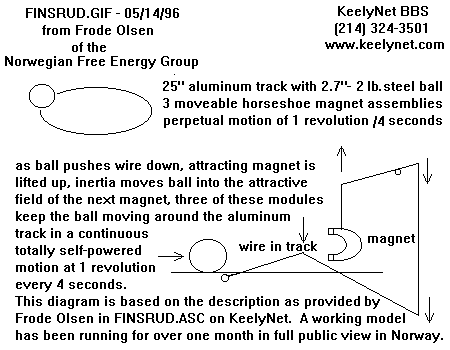Finsrud Perpetual Motion Machine
This file was first posted on the KeelyNet BBS as FINSRUD.ASC on 05/14/96,
courtesy of Frode Olsen.
This amazing report comes to us from Frode Olsen of the Norwegian Free Energy
Group. A diagram has been created from the text description to further
understand the nature of the machine. Note, the diagram could be in error, but
it makes sense as s hown, though a pendulum action might be the true way it
works, we will update as more info comes in. The image file is listed on
KeelyNet as FINSRUD.GIF. This text file and the .GIF are bundled as
FINSRUD.ZIP.
As of 05/17/96, there is a translation available of the TV2 interview.
It is FINSRUD2.TXT .
As of 06/18/96, there is a 'key' document explaining how the thing
works, listed at FINSRUD3.TXT .
Mr. Finsrud's PMM (perpetual motion machine)
This is a very short notice on the PMM of Mr. Reidar Finsrud in Skaarer,
Norway. Mr. Finsrud is a painter and makes sculptures, an artist. He started
the design of his PMM, or as he says, his 'moving sculpture' or 'sculpture'
twelve (12) years ago...
The whole machine is placed inside a glass mount, to prevent visitors who view
the machine in the gallery from touching it. All the parts and the internal
workings of the device are clearly visible in a video made by the Norwegian
channel 2 (TV 2).
A steel ball (about 2.7 inch diameter, 20 pound) is rolling on an
aluminum track, about 25 inch in diameter, placed horizontally. Three
pendulums, about 45 inch long with tuneable weights at the lower end,
controls three horse-shoe magnets that the steel ball has to pass by on the
track. Embedded in the track is a (mechanical) controlling/timing mechanism.
It looks like a steel wire bent into a triangular track, 5 inches long. The
ball rolls over it and pushes the wire down through a slot in the track. This
affects one of the pendulums and regulates its swinging motion.
 There are three of these, one for each pendulum that needs to be controlled.
The three horse-shoe magnets are mounted on a lever, one on each pendulum.
Three much smaller magnets, also connected to the pendulums, are placed a bit
further down the track from the horse-shoe magnets. These hardly move, or do
not move at all when the ball passes.
The timing is such that the horse-shoe magnets are raised towards the
ball just before it reaches them, a 'wave-motion' created by the raising
magnets pulls the ball around the track. The ball makes one revolution in
about 3 seconds.
The inventor is currently displaying the device in his art gallery. It
is open for the public. He seems very open about his 'moving sculpture'. He
has no formal training in mechanics or physics. The ball has at present
been in constant motion on the track for about one month.
An estimate of the power: If we assume the ball would come to a complete
stop after 30 seconds with a starting velocity of 1 m/s without the
magnets, the energy of the ball: E = 0.5 * m * V * V = 5 Joule would be
spent.
Since P= E/t this gives a power loss along the track of P = 5 / 30 =
0.16 Watt.
This is well below Dr. Hal Puthoffs' '1 Watt Challenge'. BUT, the total
ENERGY that the device has already produced is Etot = P * t , taking t = 1
month Etot = 0.16 * 2 592 000 s = 414 720 Joules
This is a VERY large amount of energy. There will be more info available
in the near future. We will try to get the exact design description from
the inventor. I have a rather poor VHS copy of the program as it was
broadcast on Nowegian TV Channel 2. With a little help I could convert it to
the American video standard.
There are three of these, one for each pendulum that needs to be controlled.
The three horse-shoe magnets are mounted on a lever, one on each pendulum.
Three much smaller magnets, also connected to the pendulums, are placed a bit
further down the track from the horse-shoe magnets. These hardly move, or do
not move at all when the ball passes.
The timing is such that the horse-shoe magnets are raised towards the
ball just before it reaches them, a 'wave-motion' created by the raising
magnets pulls the ball around the track. The ball makes one revolution in
about 3 seconds.
The inventor is currently displaying the device in his art gallery. It
is open for the public. He seems very open about his 'moving sculpture'. He
has no formal training in mechanics or physics. The ball has at present
been in constant motion on the track for about one month.
An estimate of the power: If we assume the ball would come to a complete
stop after 30 seconds with a starting velocity of 1 m/s without the
magnets, the energy of the ball: E = 0.5 * m * V * V = 5 Joule would be
spent.
Since P= E/t this gives a power loss along the track of P = 5 / 30 =
0.16 Watt.
This is well below Dr. Hal Puthoffs' '1 Watt Challenge'. BUT, the total
ENERGY that the device has already produced is Etot = P * t , taking t = 1
month Etot = 0.16 * 2 592 000 s = 414 720 Joules
This is a VERY large amount of energy. There will be more info available
in the near future. We will try to get the exact design description from
the inventor. I have a rather poor VHS copy of the program as it was
broadcast on Nowegian TV Channel 2. With a little help I could convert it to
the American video standard.
(Frode Olsen) of the Norwegian Free Energy Group

